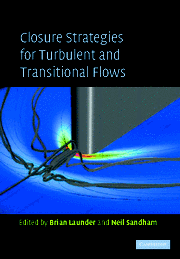14 - Application of TCL Modelling to Stratified Flows
Published online by Cambridge University Press: 06 July 2010
Summary
Introduction
Chapter [3] has provided the rationale and the associated analysis for replacing the Basic Model of the pressure-strain process in second-moment closure by a more widely applicable approach – namely one satisfying the two-component limit (TCL). The present chapter will show that extending that model to include flow problems where gravitational effects are important also brings clear benefits in terms of accuracy and, sometimes, reductions in computing times, too.
However, not all closure problems in stably-stratified flows can be resolved merely by ensuring that the non-dispersive pressure-containing correlations satisfy the two-component limit. If generation by mean shear is effectively obliterated by the sink associated with the stable stratification, the computed behaviour of the second moments becomes particularly sensitive to secondmoment transport processes. While convective transport is, of course, handled exactly at this closure level, the same is not true of diffusive transport. Usually a very simple gradient-diffusion model is adopted for these processes. Such a practice, however, is motivated by the desire to adopt a cheap and stable approximation for a process that is frequently of little importance. However, transport can be of great importance in strongly inhomogeneous, stably-stratified flow – so something better must be provided.
Section 2 focuses on modelling the extra pressure-containing correlations arising from buoyancy and provides a comparison of computational results from implementing this model both with experimental data and, where available, with the Basic Model. Then Section 3 goes on to consider a case of a stably-stratified mixing layer where a partial third-moment treatment is required. The analysis is first developed before comparisons with experiments are discussed.
Closure Modelling for Stratified Flow
The Second-Moment Equations
The equation set (2.1)–(2.4) is, of course, unclosed, for the processes denoted ϕ, d and ϵ (representing the non-diffusive action of fluctuating pressure, diffusion and dissipation) all require approximation. In this section, we focus especially on the modelling of ϕij and ϕiθ for, in the flows to be considered, these are the vital processes to be approximated. As a preliminary, however, the following paragraphs indicate briefly the practices adopted for the dissipation and diffusion processes.
- Type
- Chapter
- Information
- Closure Strategies for Turbulent and Transitional Flows , pp. 407 - 423Publisher: Cambridge University PressPrint publication year: 2002
- 3
- Cited by



